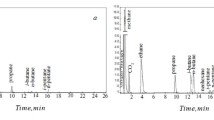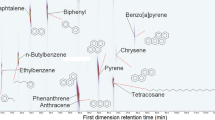Abstract
Operational characteristics of the combined continuous and preparative gas-liquid Chromatographic system were investigated for the separation of two close-boiling components, diethylether and dichloromethane. It was experimentally confirmed that the additional column length and the desorbent velocity were the most important factors to ensure the continuous separation of the feed mixture.
The theoretical concentration profiles derived with the assumptions of the uniform film thickness and linear partition equilibrium were in relatively good agreement with the experimental data for the combined continuous and preparative Chromatographie system, and it could be used as a powerful predictive tool for determining the optimum operating conditions.
Similar content being viewed by others
References
Bonmati, R.G., Chapelet-Letourneux, G. and Margulis, J.R.:Chem. Eng.,87, 70 (1989).
Barker, P.E.: “Developments in Chromatography ”, Knapman, C.H. (Editor), Applied Science Publisher, London(1978).
Grushka, E. (Editor): “Preparative-Scale Chromatography ”. Marcel Dekker, Inc., New York and Basel (1989).
Row, K.H.: Ph.D. Thesis, Korea Advanced Institute of Science & Technology, Seoul (1986).
Row, K.H. and Lee, W.K.: “Separation by GasLiquid Chromatograph”, Cheremisinoff, N.P. (Editor), Handbook of Heat and Mass Transfer, Vol. 3: Catalysis, Kinetics, and Reactor Engineering, Chapter 22, Gulf Publishing Company, Houston (1989).
Row, K.H. and Lee, W.K.:Sep. Sci. and Technol.,22, 1761 (1987).
Broughton, D.B.:Chem. Eng. Pro.,64, 60 (1969).
Ching, C.B. and Ruthven, D.M.:Chem. Eng. Sci.,40, 1411 (1985).
Fish, B.B., Carr, R.W. and Aris, R.:AIChE J.,35, 737 (1989).
Row, K.H. and Lee, W.K.:J. Chem. Eng. Japan,19, 173(1986).
Alkarasani, M.A. and McCoy, B.J.:Chem. Eng. J.,23, 81(1982).
Dang, N.D.P. and Gibilaro, L.G.:Chem. Eng. J.,8, 157(1974).
Moon, I., Row, K.H. and Lee, W.K.:Korean. J. Chem. Eng.,2, 155(1985).
McNair, H.M. and Bonelli, A.J.P.: “Basic Gas Chromatography”, Varian Aerograph, Berkeley (1969).
Littlewood, A.: “Gas Chromatography”, Academic Press, New York (1970).
James. A.T. and Martin, A.J.P.:Analyst,77, 915 (1952).
Row, K.H.:Chromatographie,25, 961 (1988).
Author information
Authors and Affiliations
Rights and permissions
About this article
Cite this article
Row, K.H., Lee, Y.Y. & Lee, W.K. Separation of close-boiling components by the combined continuous and preparative chromatography: Comparison of experimental data with calculated values in binary system. Korean J. Chem. Eng. 7, 210–218 (1990). https://doi.org/10.1007/BF02697353
Received:
Accepted:
Issue Date:
DOI: https://doi.org/10.1007/BF02697353




